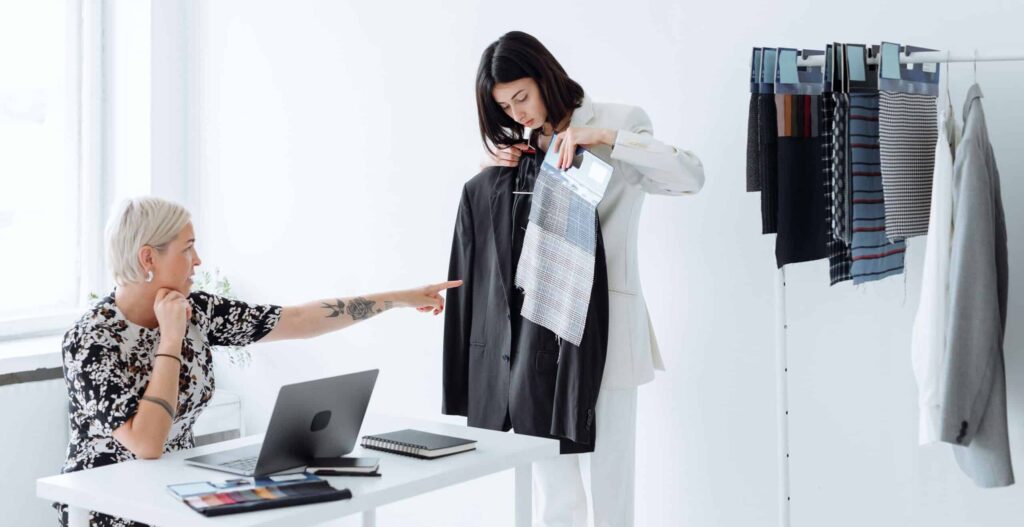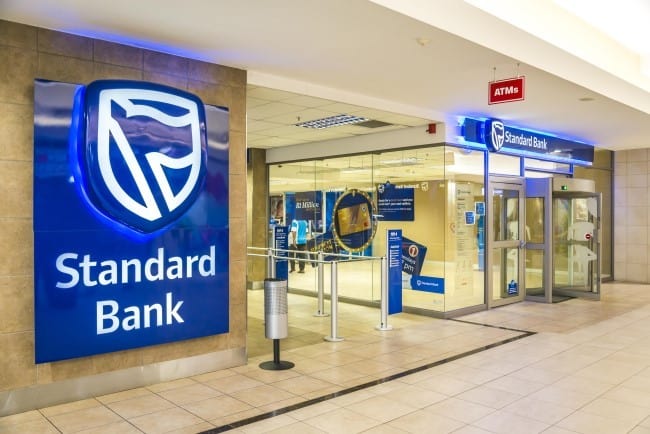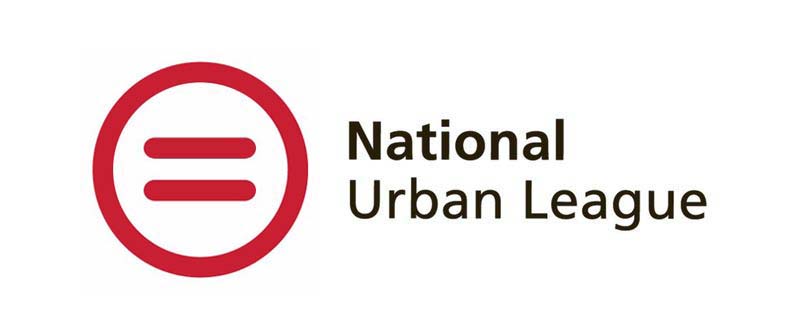As someone who started their career working remotely in the midst of a pandemic, terms like “business casual” terrified me when it came time to finally step foot in an office. All I knew about business attire was that it was better to be overdressed than underdressed, but after a year of working in a variety of sweatpants, pajamas, and shorts, I wasn’t even sure what the baseline was.
Luckily, you don’t need to be as terrified as me if you’re trying to dress business casual in 2025. We consulted top fashion experts to help define what business casual attire means, learn how the dress code has changed in recent years, and show us how to dress for it.
What Is Business Casual?
“Business casual” is a dress code where the term translates precisely to what it means: a mix of formal and casual clothing. It’s less formal than business wear, like suits, but still professional. It’s one of many types of business attire that people wear in the workplace.
This dress code can be a bit harder to define in practice because it doesn’t have a set “look.” It’s not a pants suit, but not jeans and a t-shirt, either. Cue my first-day-in-the-office panic. So, what do the fashion experts think?
“I consider business casual to be a seamless blend of ‘elegant’ and ‘effortless,’” De Anne Combs, fashion, textile, and travel expert and co-founder of La Peony, an ethical women’s luxury clothing collection, says. “It’s an upscale look that’s chic enough to command attention yet understated enough not to overwhelm.”
>>MORE: What to Wear to a Job Interview
MaryKathryn McArthur, lead stylist at Short Story, a DTC retailer and personal styling service helping petite women, agrees that business casual is all about balance — “that harmonious balance between a suit set and weekend wear,” she says.
McArthur also believes this dress code allows for more personality and style.
“It brings a level of comfort to the table, not only because you can avoid a stiff suit, but also because you feel more YOU!” she says. “Depending on your workplace, this can mean a pair of black or dark wash jeans paired with a nice blouse that can be elevated with a chic blazer.”
So, according to the experts, business casual is all about balance, allowing room for your personality while elevating an everyday look.

Building Your Personal Brand
Your clothes should show your personality, but what about your social media? Learn how to make your brand stand out to employers on LinkedIn.
Avg. Time: 2-3 hours
Skills you’ll build: Image, reputation, online presence management, brand management, LinkedIn
Examples of appropriate clothes for business casual include:
- Blouses
- Dress shirts
- Button downs
- Polos
- Slacks
- Khakis
- Trousers
- Dress pants
- Longer skirts
- Midi dresses
- Blazers
- Boots
- Loafers
- Scarves
Business Casual vs. Business Professional
On the casual attire to formal attire spectrum, business casual and business professional are right next to each other, with business professional being slightly more formal.
Business casual is all about dressing down a more formal business attire, while business professional is the midway point between business casual and formal.
Both styles might include similar items: dress shirts and dress pants, blazers, trousers, or loafers. However, business professional is slightly more rigid and conservative, while business casual allows for more flexibility in styling, color, and pattern.
>>MORE: Learn about all the different types of business attire (and when to wear each of them.)
How to Figure Out What Business Casual Looks Like at Your Company
Business casual may look different depending on the workplace. For example, jeans might be more common at a laid-back startup, and blazers might be the go-to for a marketing agency where clients regularly visit the office. So how can you figure out just what your company means by “business casual” at the office?
Luckily, you don’t have to go into the office without any idea of what business casual means at that particular company. Instead, do your research. Look for pictures of employees working at the company, which you can find on LinkedIn, company website, or social media.
You can also ask what business casual looks like at the company! If you’re in the interview process, ask the recruiter about the specifics of dress code. And if you’re onboarding, ask your hiring manager if there are any guidelines you should be aware of before your first day.
There’s no shame in asking what the dress code is — in fact, it can even show how you’re trying to be respectful of the company culture. It can also save you from an awkward first impression!
When I went into the office for one of my first internships, I decided to wear a pair of smaller heels, then quickly found out that the office was much more business casual, or even smart casual. Luckily, I had brought a pair of nicer sneakers in my bag. I quickly changed and felt much more comfortable — but was embarrassed I was lugging some heels around in my bag! If I had just asked my future bosses, it would have saved that awkward quick-change moment.
If you don’t have a chance to ask the recruiter or hiring manager or you’re still unsure, you should always err on the formal side.

Interview Success
Ace the interview by learning common interview questions and practicing how to answer them.
Avg. Time: 4-5 hours
Skills you’ll build: Public speaking, poise, communication, presentation
How Has Business Casual Changed in the Last Few Years?
The workplace has changed in countless ways since the start of the pandemic, dress codes included — which made it a lot harder to know what the trends would be when many people returned to work (again, cue my fashion crisis).
Looking back now, we know that workwear had a shift toward the casual. After many people worked from home and enjoyed the comfort of more casual looks, they kept the emphasis on comfort as they were called back to the office.
“We traded dress pants for leggings and sweats became tailored ‘streetwear,’” Combs says. “Even high-heeled pumps transitioned into slides or upscale sneakers. Previously, I wouldn’t have envisioned boyfriend jeans or any of the above items working well at an office meeting or birthday brunch. Thanks to some stylish updates, however, they not only work — they’re a sophisticated wardrobe choice!”
McArthur believes this focus on comfort has also allowed professionals to “let more of themselves come through” in their workwear, especially if working from home.
“You’re going to be discussing millionaire dollar deals one minute, and then feeding your dog the next, so you’ll want to feel 100% in your element.”
>>MORE: How to Find a Job You Love: 3 Things to Do (and 4 to Avoid)
Business Casual Outfits for Women in 2024
Fashion experts predict business casual for women in 2025 will be all about accentuating the basics and showing off your unique style.
For example, Giovanni Bordone, professor of fashion at London Metropolitan University, says that dark suits will return to style but “with a different touch, such as a fancy scarf, a pair of funky sneakers or a colorful sweater.”
Bordone says women will continue to use suits for “power dressing” in 2025, “but will move into a more personalized and individualized look where the accessories are playing a defining role.” This will make the formal “suit” look a little more casual to fit the dress code.
>>MORE: Zoom Interview Attire: What (and What Not) to Wear
So, what items should women wear to fit a business casual dress code in 2025?
Shirts
Blouses, button downs, knit tops, and sweaters are all great options for business casual tops for women. While t-shirts are generally a no-go for business casual — unless your company is more relaxed — you can still stay cool in this business attire by opting for lightweight fabrics like linen.
Don’t be afraid to be more bold with color choices! Tops in non-neutral colors, like vibrant palettes or pastels, are all fair game.
Jackets
Blazers can be a great way to dress up the top of your business casual outfit. For these, opt for more neutral colors like navy, gray, or black so they’re more versatile — and you can throw them over your more bright or bold tops.
Pants
Wide-legged pants are all the rage in 2025. Whether or not you want to fit the trends, opting for non-jean pants is typically safe. Tailored pants, trousers, khakis, and even cargo pants are all good options.
While there are tons of fun patterned pants out there, business casual pants should typically be solid colored. That doesn’t mean you can’t choose more fun colors, like eggplant or olive!
Dresses
Length and tightness are the two main factors you should consider when picking a dress for business casual attire. Typically, dresses should be about knee length or longer and shouldn’t be too form-fitting.
Shift dresses, wrap dresses, and midi dresses are all great options. You can get more expressive here with colors and patterns as well.
Shoes
Closed-toed shoes are the way to go for business casual. Instead of sandals or flip-flops, opt for boots, loafers, or flats. While heels are standard in more formal dress codes, you can wear them for business casual, too, especially to elevate a more casual look.
Sneakers aren’t totally off the table, depending on the workplace. However, make sure these sneakers aren’t the running or gym kind — stylish or designer sneakers are a better option.
Accessories
Accessories are a great way to show off your personality with a business casual dress code. Scarves, jewelry, and even bags can add a little flair, as long as they’re not too distracting or flashy.
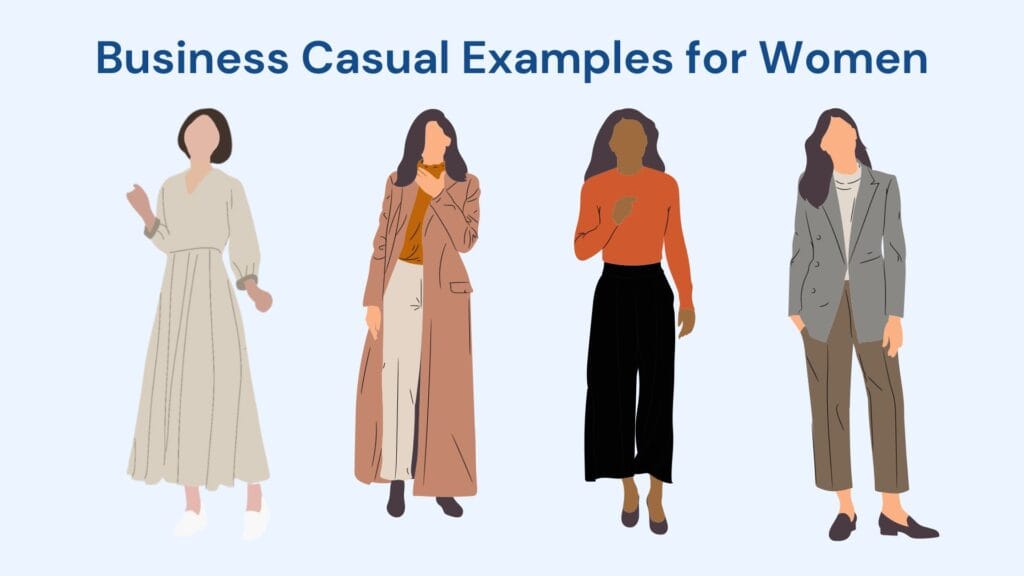
Business Casual Outfits for Men in 2024
In 2025, business casual for men will also focus heavily on the “casual,” according to Combs. She says we’ll see a “return to some fun, old-school elements from the pre-millenium era. Neckties, baggy pants, low-riding waistlines, patchwork fabrics, and denim-on-denim outfits are just some of the latest runway styles.”
So what does that mean for those not on the runway (and just in the office hallway)?
Shirts
Classic shirt options like button downs, Oxford shirts, or Henley shirts are perfect for men’s business casual attire. In cooler seasons, sweaters are the perfect fit; in warmer seasons, you can also opt for short-sleeved polo shirts.
Like women’s business casual attire, there is more freedom in what kinds of patterns and colors you can wear for shirts and sweaters — bold colors and patterns are OK.
Jackets
Blazers, bomber jackets, and even denim (in slightly more casual offices) are great ways to layer a business casual look. Neutral colors can help make these items more versatile.
Pants
Business casual pants for men should be in between suit pants and jeans. Chinos, khakis, linen pants, trousers, and dress pants are all great options. Like the jackets, opting for more neutral colors can make these items more versatile.
Shoes
While dress shoes are always an option for business casual attire, more casual options like loafers, boots, oxfords, and derby shoes are also a great fit. Sneakers can also be OK for more casual offices, as long as they’re non-running ones.
Gender Neutral Business Casual Outfits for 2024
Regardless of your gender expression, there are tons of options for business casual outfits in 2025. You’ll want to balance the formal and casual style while adding in a bit of your personality, whether that’s with a print, bold color, jewelry, or accessory. Examples of gender neutral business casual trends include:
- Blazers
- Dress sneakers
- Relaxed pants or slacks
- Bold color dress shirts or tshirts
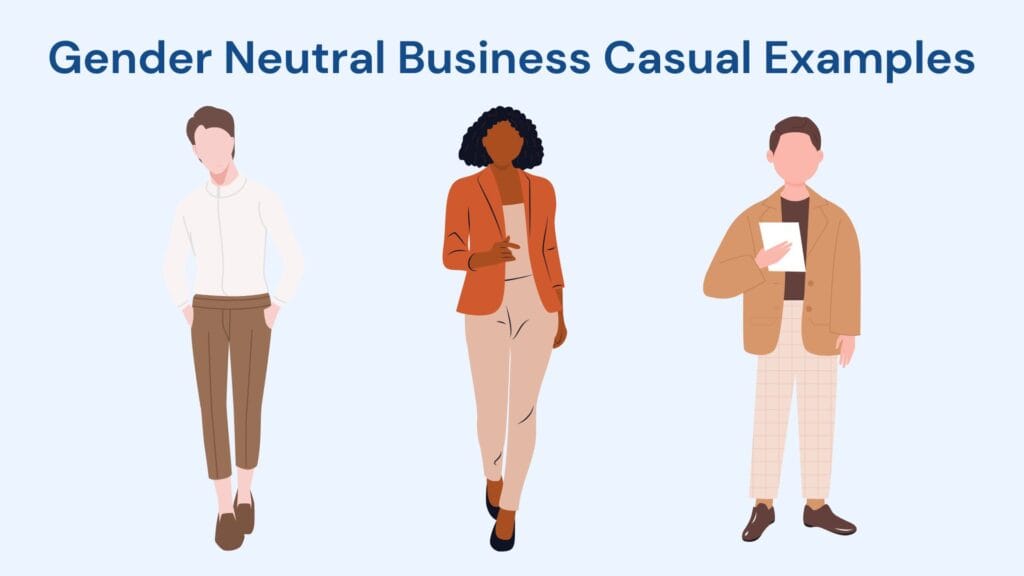
What Should You Avoid Wearing for Business Casual in 2024?
In years past, certain clothing items were seen as off-limits or inappropriate for a business casual dress code. Off-limit items included jeans, shorts, and short dresses and skirts.
In 2025, this dress code isn’t as strict as it was pre-pandemic, but it’s still inappropriate to wear:
- Torn or ripped clothing
- Clothing with offensive or inappropriate messaging
- Revealing items, including see-through items that reveal undergarments
- Athleisure
- Dirty clothes
Are Jeans Business Casual?
Generally, no, jeans are not business casual. Regardless of your gender identity, opting for non-jean pants like chinos, khakis, dress pants, trousers, or tailored pants are a great option.
However, some workplaces that are more casual and less conservative may accept jeans as part of business casual attire. Don’t assume this is the case during the interview or on your first day — wait to see what your coworkers are wearing before wearing jeans to the office. And if you do wear jeans, opt for non-ripped pairs in a darker wash.
Business Casual in 2024: The Bottom Line
Business casual sticks true to its name: it’s a blend of formal and informal wear. To fit this dress code, you’ll need to look professional and put together, but that doesn’t mean you need a suit. You can be casual and dress more to your personality — just not the same way you would to lounge around your house on the weekend.
In 2025, business casual is more about the “casual,” and trends will encourage professionals to show more of their style in their outfits. To fit the dress code, wear comfortable yet professional items that make you feel confident and ready to take on your work while following the dress code set forth by the company.
Get ready to join the workforce with resume, interview, and professional tips from Forage job simulations.
Image credit: Thirdman / Pexels
